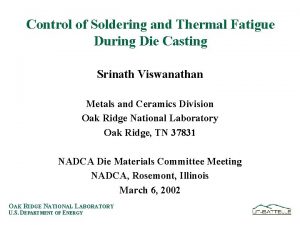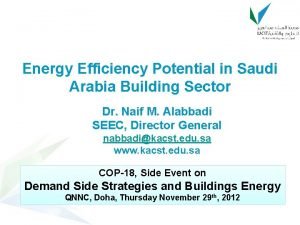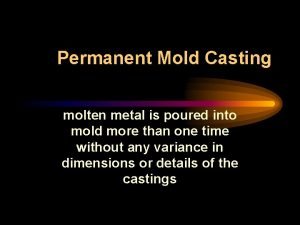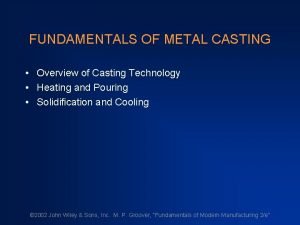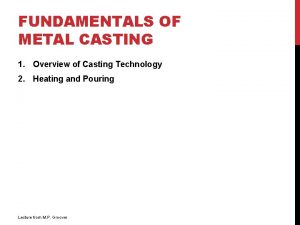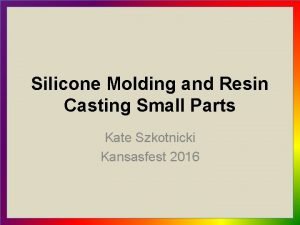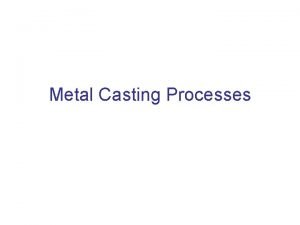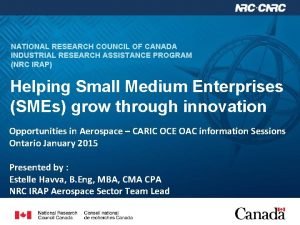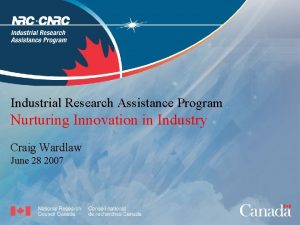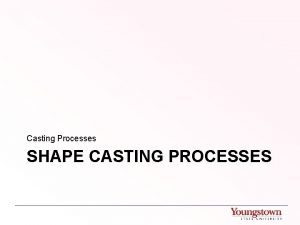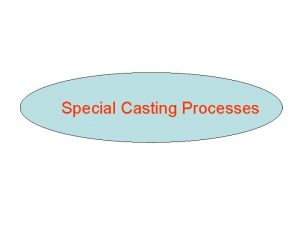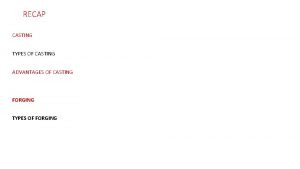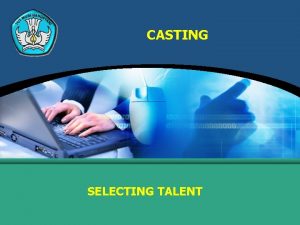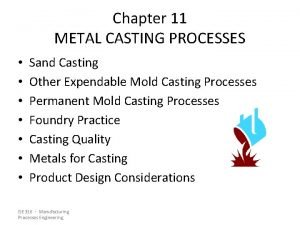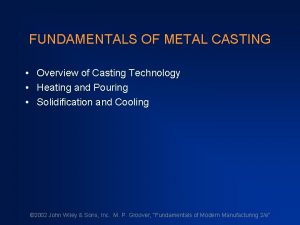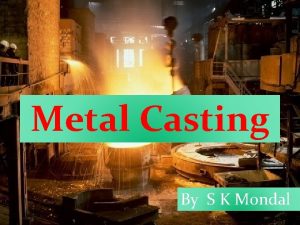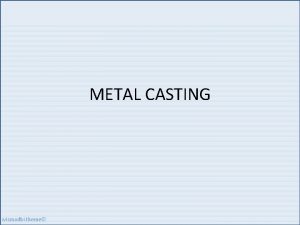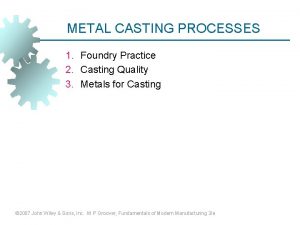Metal Casting Research Industrial Technologies Program Energy Efficiency














- Slides: 14

Metal Casting Research Industrial Technologies Program Energy Efficiency and Renewable Energy U. S. Department of Energy Dr. Ehr Ping Huang. Fu Presentation to: Policy Implementation Committee China September 22, 2003

Industry Overview • U. S. Metalcasters consume over $1 billion in energy (328 trillion Btu) per year • Over 2, 700 metalcasters in the U. S. • Total industry employs about 225, 000 people • Small business industry - 94% of metalcasters employ less than 250 people

Government-Industry R&D Partnership in Metal Casting • Department of Energy Role • Industry Role – through the Cast Metals Coalition (AFS, NADCA, SFSA) - - Improve energy efficiency in U. S. industry Improve environmental performance Foster R&D collaboration within industry and academia emphasizing university-based R&D Promote R&D needed by this small business industry Provide leadership to and direct participation from industry Transfer developed technologies to industry

Program Strategy: Vision & Technology Roadmap • Metalcasting Industry Vision first developed in 1995 - Evaluation of the current state and a vision for its future - Formation of public-private partnership • Technology Roadmap developed in 1998 - Products and Markets Manufacturing Technologies Materials Technology Environmental Technologies

A New Vision • A new Vision was completed in 2002 and a new Roadmap is near completion • Available at www. oit. doe. gov/metalcast • Communicate its essential value to the U. S economy, • Improve casting design methods to open new markets and applications, • Improve the understanding and control of metalcasting processes, • Improve alloy and geometry performance, • Attract employees and students to the industry

Performance Goals • By 2020, energy use in casting will be reduced by 20% compared to 1998 energy requirements • Non-recycled solid waste and toxic chemical releases will be reduced by 25%

Achievements • Broad Participation and Outreach Hundreds of organizations from across the U. S. have participated in costshared metalcasting research including small-, medium-, and large businesses, universities, laboratories, and federal agencies. • Partnership with Leveraged R&D Resources 100 million dollars have been invested in metalcasting research, including investment from industry and the federal government. • Efficient Technology Transfer Multiple R&D consortia have been fostered, resulting in broad information sharing and technology transfer. • Future Casting Workforce University-based research has trained hundreds of students, the majority of whom have gone on to careers in metalcasting. • Enhanced Engineering Standards/Metallurgical Curriculum Research results are being incorporated into the curriculum of U. S. colleges and universities, in some cases updating guidelines and instructional materials for the first time in decades.

Selected Research Highlights • Advanced Lost Foam (Univ. of Alabama) • New design rules and unconventional approach for yield improvements in steel (Univ. of Iowa) • Rapid Solidification Prototype Tooling (Colorado State Univ. ) • Performance Data to Increase Reuse of Spent Foundry Sand (Penn State Univ. )

Advanced Lost Foam • Allows highly complex parts to be cast in one piece • Saves energy through reduced machining and assembly operations • No additives required in conditioning sand thereby making sand reusable • Saves energy by eliminating the core and through higher yield (less metal must be melted) • Clean Process / Higher Yield

Studies in Progress • Metal Casting “Energy Footprints” Study (planned completion date: 12/2003) • Theoretical/Practical Energy Use in Metal Casting Operations (planned completion date: 12/2003)

Metal Casting “Energy Footprints” Study Purpose: • Determine the energy use per unit of output for the various segments of the industry Methodology: • Individual assessments of 15 “typical” metal casting facilities. • Utilization of Industrial Assessment Center Database • State metal casting energy studies • Metal casting literature searches

Theoretical/Practical Energy Use in Metal Casting Operations Purpose: • Evaluate theoretical and practical potential for reducing energy requirements to produce 1 ton of molten metal in metal casting operations Methodology: • Conduct literature search to identify information and data on metal casting energy consumption and energy reduction • Compile and analyze data to evaluate theoretical minimum, best practice minimum, and practical minimum energy requirements • Evaluate the potential for application of Combined Heat and Power techniques in the metal casting industry • Explore feasibility of a standard test to measure energy use

Future Research Direction • Advanced Melting Technologies – Optimize furnace size/type for application, improve melting and holding technologies – Improve riser designs – Reduce variability – Sensors & Controls – Ladle & Transfer • Innovative Casting Processes – – – Lighter weight castings Improve ability to cast non-ferrous Lost Foam Computer Modeling in Die Casting Low Cost Semisolid Feedstock Alloy diversification in permanent mold

Contact Information For additional Information, please browse: http: //www. oit. doe. gov/metalcast/ or Contact: Ehr Ping Huang. Fu/EE-2 F Energy Efficiency and Renewable Energy U. S. Department of Energy 1000 Independence Ave. S. W. Washington, D. C. 20585 202 -586 -1493 (Voice) 202 -586 -6507 (Fax) Email: ehr-ping. huangfu@ee. doe. gov
 Tte casting technologies inc
Tte casting technologies inc Saudi energy efficiency program
Saudi energy efficiency program Renewable energy and energy efficiency partnership
Renewable energy and energy efficiency partnership Allocative efficiency vs productive efficiency
Allocative efficiency vs productive efficiency Productively efficient vs allocatively efficient
Productively efficient vs allocatively efficient Allocative efficiency vs productive efficiency
Allocative efficiency vs productive efficiency Graphite permanent mold casting
Graphite permanent mold casting Fundamentals of casting
Fundamentals of casting Fundamentals of metal casting
Fundamentals of metal casting Casting small parts
Casting small parts Chills in casting
Chills in casting Industrial research assistance program
Industrial research assistance program Industrial research assistance program
Industrial research assistance program Solid particles diagram
Solid particles diagram Density of metalloids
Density of metalloids
